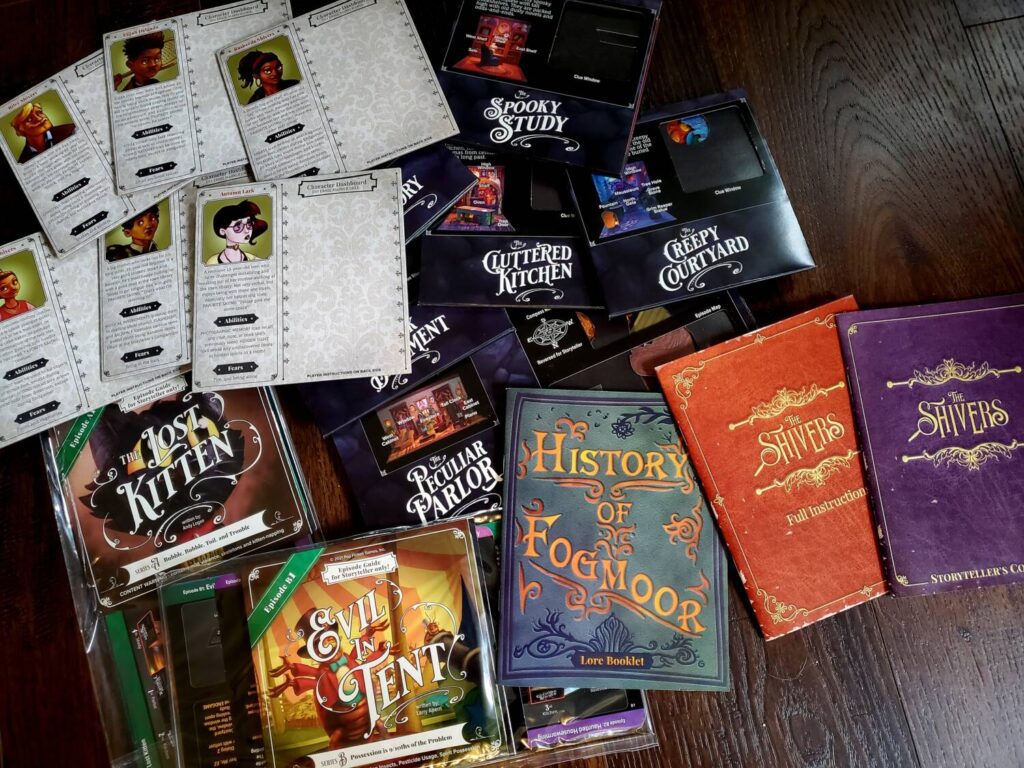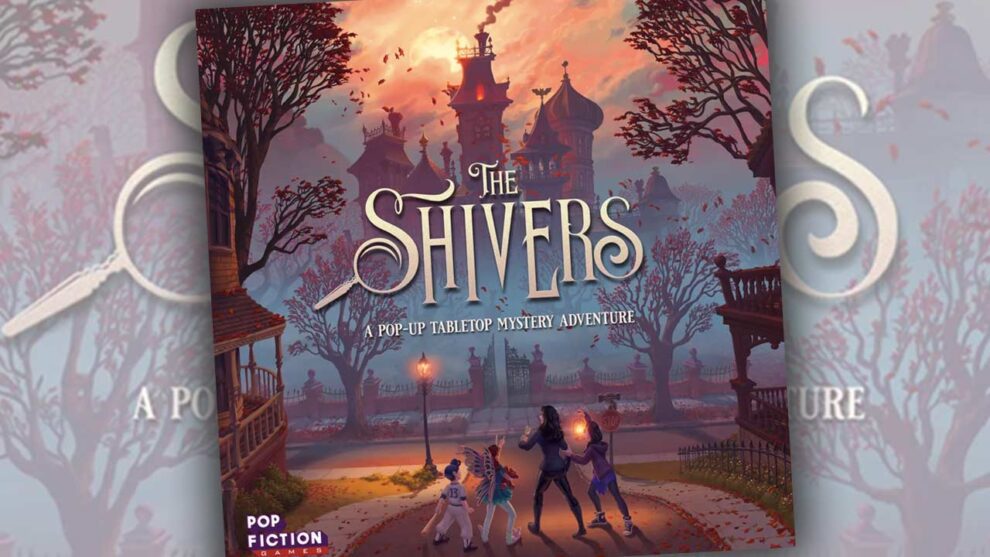When I was a kid, pop-up books were rather rudimentary, but even then I was enthralled by the possibilities. Today I am thankful for names like Matthew Reinhart and Robert Sabuda, creatives whose efforts have produced some of the pop-up books that grace our kids’ shelves. Few of these intricate productions survive intact, but that is only due to the vigor with which they are engaged and enjoyed in our home. They are popped until they drop.
It should come as no surprise, then, that The Shivers drew my attention. Described as a “Pop-up Tabletop Mystery Adventure” by the folks at Pop Fiction, this inaugural design from Andy Logan is the sort of box that begs investigation—both of the product itself and within the story it aims to tell. Players work together to solve a mystery via the clues dropped all over the pop-up rooms representing the Shivers family house in Fogmoor.
Before I ever cracked the shrink on the box, though, I trembled at the other side of the coin. The Shivers is also something of a role playing game. One player assumes the responsibilities of the Storyteller, sitting behind the pop-ups leading and guiding the others through the scenario. The intended experience, then, also involves the other players loosely “becoming” the characters represented on their standees in order to achieve the full effect of the design. As it turns out, Bob isn’t much for roleplaying. I knew this, and yet I couldn’t resist trying (in part because I knew it was roleplaying on 5 rather than roleplaying on 10).
I am that gamer—nearly but not exactly the intended audience—who is intrigued by the package but wary of the style of play. I feel it only fair to mention my bias before diving into the haunted place.
As the Storyteller
The Shivers is designed to be an introductory roleplaying (RPG) experience. Players don’t need to get into character. The Storyteller doesn’t need to improvise. But The Shivers will be a better game if you approach the table with an open mind, a creative spirit, and a willingness to let your hair down.
The Storyteller’s Companion booklet is a how-to guide for running the game. With sections titled “Setting the Mood”, “Improvising”, “Concluding a Game”, “Helping Players”, and lists of dice results, scenario details and complications, and items in the various scenes, this little resource is a 16-page welcome to the game box.

The Full Instructions booklet includes fifteen pages of gameplay details—also intended primarily for the Storyteller. In short, The Shivers begins with a cup of coffee, a bit of quiet, and some manageable study. The Storyteller’s job is pivotal to the experience, and the Storyteller needs to own up to that role. Greater familiarity will equal greater enjoyment for everyone.
If you have zero experience (and perhaps a smidge of curiosity) with role playing games, The Shivers might be a great place to start. The rails are secure. The research is thorough. The entire scene lays before you in its folded paper glory, ready for engagement. The standing back of each pop-up room has a sleeve to receive the scenario’s detail card. The front side will display new images to the players, while the back contains color-coded descriptions for your eyes only. The booklets are thorough as training tools. There is an introductory scenario designed to warm you up and teach the gameplay basics. You really can’t go wrong. If no one at the table has any RPG experience, just have a conversation at the beginning to acknowledge that you’re all learning and approach that first play charitably.

If you have experience with RPGs, you will probably find a lot of the information redundant, but it’s still worth a read to make sure you are honoring the spirit of the game. You already know that your attention to detail will determine the rest of the team’s comfort in the experience.
As a Player
On each turn, players are responsible for advancing the story with roughly five seconds of improvised (but often obvious) action. Open the base of the grandfather clock. Try the door on the western side of the room. Can I dance a jig on top of the piano? Sometimes these actions are necessary and swift. Sometimes they are wonky and posed in the form of a question. In these cases, three dice with varying success rates determine the outcome of the request. The Storyteller can decide how often to employ the dice and where. There are rules, but there are also opportunities to fit the experience to the group at the table.

Storyteller training involves learning when to drop hints and when to let the crew sweat it out. Being the crew just involves the sweat. Sometimes you need (and hopefully receive) subtle hints. Other times a more persistent, gentle leading is required. As different Non-Playable Characters (NPCs) enter the scene, the Storyteller is the one in control, progressing the plot and helping the characters to find actionable choices. As players, you react as your character might react.
The game goes round and round, cycling through turns until success or failure defines the day.

Obviously I’m avoiding spoilers here, but I will add I’m on the less experienced side. RPGs rarely interest me. But the non-RPG-ness of The Shivers made me brave. Open-ended turns are frightening at first. What should I do? Anything I want? What does that even mean? Well, I guess I’ll jiggle this door handle and see what happens. Yes, these are actual thoughts that run through my head with even the most elementary RPG feature. I worked through them.
The pop-up rooms are cute and engaging for all, especially at the beginning. The grand reveal as a room comes into sight is a treat (we started with the rooms hidden and the Storyteller flipped them as needed). I was reminded a bit of MicroMacro: Crime City in our introductory scenario as four of us nearly knocked heads trying to scope out the details in the smallish rooms to make decisions. The turn structure is helpful, but everyone wants to have a peek. Exercise caution or wear a helmet.

Each player has a dry-erase board to record relevant information, objects acquired, or anything else they see fit to doodle. These were helpful as the scenarios progressed, but you can only write so small with those boards, so don’t expect to keep a journal. Likewise the standees are helpful in the moment for remembering the scene and how exactly your compadres are scattered about.
The first game session was pretty delightful overall. Our Storyteller brought a lot of RPG experience to the table and introduced us to the various possibilities gradually and with ease. We were at home in the adventure, conversing about the discoveries, and working together overall in our efforts.
What’s in the picture frame this time?
During the second scenario, though, I recognized what I would consider to be the primary flaw of The Shivers: there are only so many physical rooms in the box. Various scenarios introduce new rooms and new experiences, but any time a room is re-used, a bit of the magic has been sapped. Yes, there is a new card with new pictures on the wall, new objects in the cabinets, new NPCs, and new story elements. But once you’ve explored a room as thoroughly as you likely will the first time you see it, especially with the introductory scenario, you find you’re simply asking the same questions but receiving different answers in subsequent plays.

In metaphorical short: the gimmick tries its best to cash the checks written by the game, but sometimes the funds are a wee insufficient. Pop-ups are eye-catching, but they are expensive. There are limits to what this box can provide visually and with regard to variety. Even as it is stunning, there is an inherent repetitiveness in the box. The human imagination is more capable than the print shop, which is why RPGs are often seemingly book or card-driven with visuals as mere extras. But I will say the pop-ups bring a bit of joie de vivre to the genre for the newbie like me.
Every time Camel Up hits the table, I smile at the pop-up palm tree as I open the board. There’s a reason the race game made my Top 6 Game Components list. But there the tree is just a bit of eye candy. The game doesn’t depend on it, so of course I’m happy to see it! Here in The Shivers, the rooms are the game. They roll out gradually and with much excitement, but they also reappear, and I think it’s worth noting the effect of that repetition.
While I’m on the subject, the physical nature of a pop-up is to resist—with every pulpy fiber of its being—reaching its ideal standing position. If you expect these game boards to magically do what no pop-up in the history of pop-ups has done, you will be disappointed. They are paper and must be endured as such. The chairs will lean. The piano will lean. The cabinets might not close once they’re open. If swung open like a game board, they tear. They are as delicate as every pop-up in the history of whenever. What they do have is a magnetic connection at the base corners to keep the rooms in contact with one another, which helps keep the scenario from being tossed about, so we can celebrate that advancement!

I acknowledge the shortcomings not to berate the game, but rather to say they are all features inherent to this particular animal. They do not undermine the total experience, but if you play with a critical eye, you will see them, too.
Putting on a warm sweater
The Shivers is an experience as much as it is a game, if not more. It doesn’t have to withstand 100 plays with the same crew. This is the sort of title that gets moved around so folks can meet it, greet it, and pass it along or pick up an expansion. I commend the team at Pop Fiction for packaging a more common experience (given the rise of mystery & escape games) with an interesting component set. This is a novel way to work through a story, and I know they have intentions to grow the brand.
I can’t say The Shivers has made an RPG convert of me. But I can say that it was neat to work through. It’s the sort of game that begs to be tried, even if it’s not quite your cup of tea. If you’re into the experience, Pop Fiction has also launched a Kickstarter for the first expansion material, titled Triple Terror! with more rooms, more scenarios, and more pop-up mystery fun.












Add Comment